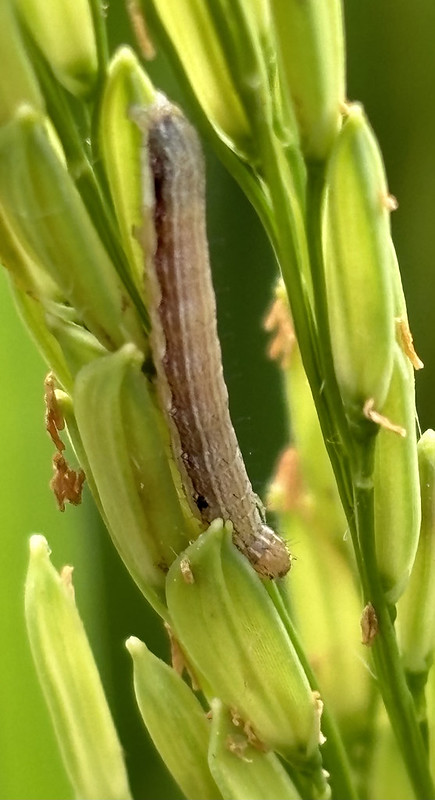By Mary Hightower
U of Arkansas System Division of Agriculture
The early summer buildup of fall armyworms in Arkansas may have spurred memories of 2021’s “wormaggedon,” but their numbers in field crops seems to have plateaued, said Nick Bateman, extension entomologist for the University of Arkansas System Division of Agriculture.
Armyworms are so named because the caterpillars appear in enormous numbers with an appetite to match. They can make grass — whether lawns, meadows or rice — disappear within a day or two.
The buildup prompted state agriculture officials to seek an emergency exemption to use the insecticide Intrepid 2F in rice to knock down populations, which was granted July 11.
Adding to the urgency was a weakened response to Lambda-cyhalothrin, a standby for farmers seeking to manage armyworms.
“Since 2021, we’ve been seeing poor control with Lambda,” Bateman said. “And that was our No. 1 control in rice.”
In 2021, farmers were finding 100 armyworms per 10 sweeps with a net in Arkansas fields. This year, farmers in southwest Arkansas started reporting armyworms in pastures as early as mid-May and by June 1, they were being found in St. Francis County rice fields.
The good news, at least for rice growers, is that the numbers of armyworms in rice seem to be static. On Monday, Bateman said “we’re getting 20-30 in 10 sweeps.”
“Rice can compensate for those numbers,” he said. “They can outgrow the damage caused by armyworms.”
Late planted rice is at the most risk right now, Bateman said, and that’s where the Section 18 for Intrepid will be of most use.
Other rice will be ready for harvest in a week or two and “we’re not worried about that rice.”
As the pressure decreases, so has Bateman’s phone time.
“My phone calls have been way down. I was getting 15-20 armyworm calls a day for 10-14 days,” he said. “Now it’s four to five calls.”
Pressure in pastures
However, farmers with pastures and hay meadows shouldn’t let their guard down just yet.
Kevin Lawson, Faulkner County extension agent for the Division of Agriculture, advised hay and forage growers on Monday to “scout if you have hay that has bermuda or crabgrass in it. Armyworms are bad again in the county.”
Kelly Loftin, extension entomologist for the Division of Agriculture based in Fayetteville, said that fall armyworm populations were “well above threshold in multiple areas of the state.
“We are seeing caterpillars of uniform size and mixed sizes that indicate overlapping generations,” he said. “Population levels of over 20 fall armyworms per square foot are not uncommon.”
Loftin said caterpillar populations have reached treatment levels around Van Buren in the western edge of Arkansas.
“From Van Buren east to Conway, south to Danville and north to Batesville, many fields with high fall armyworm numbers are being treated and have been for a while,” Loftin said.
“Some producers have having very good results with the lambda-cyhalothrin/dimilin tanks mix and others are not — leaving some bigger worms in the field,” he said. “Vantacor and Prevathon are performing very well.”
Jonathan Kubesch, extension forage specialist for the University of Arkansas System Division of Agriculture, said “I’ve seen some hard-hit fields at Hope and in Grant County. There are some other areas where I haven’t seen any at all. It seems like the best-managed forages are getting hit first, but we’ve even had some fall armyworms eating bahiagrass demonstrations in the Ouachita district” which is composed of 25 counties in the southwestern corner of the state.
“If the fall armyworms weren’t enough, Loftin said “we are also seeing readily apparent Bermudagrass stem maggot damage in bermudagrass and sugarcane aphids above treatment levels sorghum-sudangrass.”
Treatment options for fall armyworm in pastures and hayfields can be found in this factsheet, “Managing Armyworms in Pastures and Hayfields.”
Mention of product names does not imply endorsement by the University of Arkansas System Division of Agriculture.
To learn about extension programs in Arkansas, contact your local Cooperative Extension Service agent or visit www.uaex.uada.edu. Follow us on X and Instagra.m.at @AR_Extension. To learn more about Division of Agriculture research, visit the Arkansas Agricultural Experiment Station website: https://aaes.uada.edu. Follow on X at @ArkAgResearch. To learn more about the Division of Agriculture, visit https://uada.edu/. Follow us on X at @AgInArk.
About the Division of Agriculture
The University of Arkansas System Division of Agriculture’s mission is to strengthen agriculture, communities, and families by connecting trusted research to the adoption of best practices.
Through the Agricultural Experiment Station and the Cooperative Extension Service, the Division of Agriculture conducts research and extension work within the nation’s historic land grant education system.
The Division of Agriculture is one of 20 entities within the University of Arkansas System. It has offices in all 75 counties in Arkansas and faculty on five system campuses.
The University of Arkansas System Division of Agriculture offers all its Extension and Research programs to all eligible persons without regard to race, color, sex, gender identity, sexual orientation, national origin, religion, age, disability, marital or veteran status, genetic information, or any other legally protected status, and is an Affirmative Action/Equal Opportunity Employer.






